| Origin | Ischial tuberosity |
| Insertion | Medial condyle of the tibia |
| Action | Flexes knee Extends the hip Medially rotates tibia when knee is flexed |
| Nerve | Tibial nerve of the sciatic plexus (L5, S1 and S2) |
| Artery | Profunda femoris and gluteal arteries |
Location & Overview
The semimembranosus muscle is a key muscle of the hamstring muscle group. This muscle is located in the posterior and medial aspects of the thigh. Among the three hamstring muscles (semimembranosus, biceps femoris, and semitendinosus) the semimembranosus muscle is the most medial. It primarily lies beneath the semitendinosus muscle and exhibits a flatter and wider shape in comparison [1].
The semimembranosus muscle originates from the ischial tuberosity, similar to the semitendinosus muscle, and both muscles share relatively close insertion points. These two muscles are located on the medial side of the thigh, while the biceps femoris muscle is situated on the lateral side. This positioning allows the semimembranosus to work alongside the other hamstring muscles during movements of the lower limb [2].
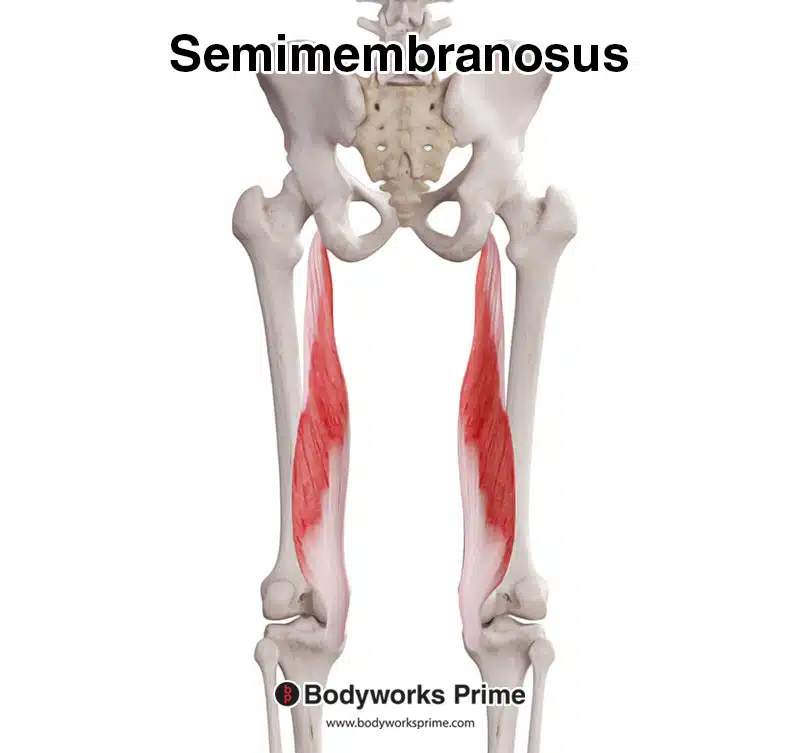
Here we can see the semimembranosus muscle from a posterior view.
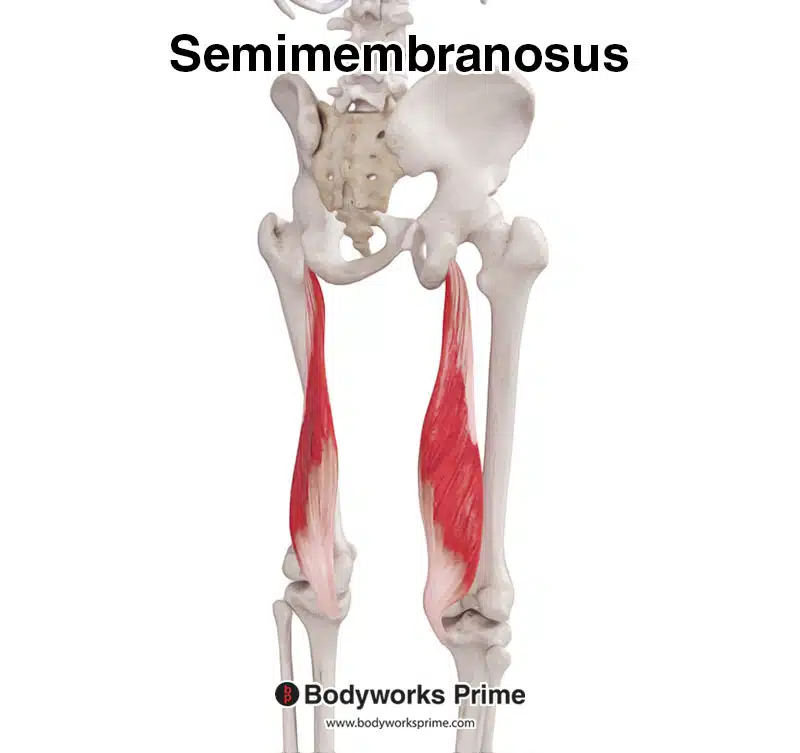
Here we can see the semimembranosus muscle from a posterolateral view.
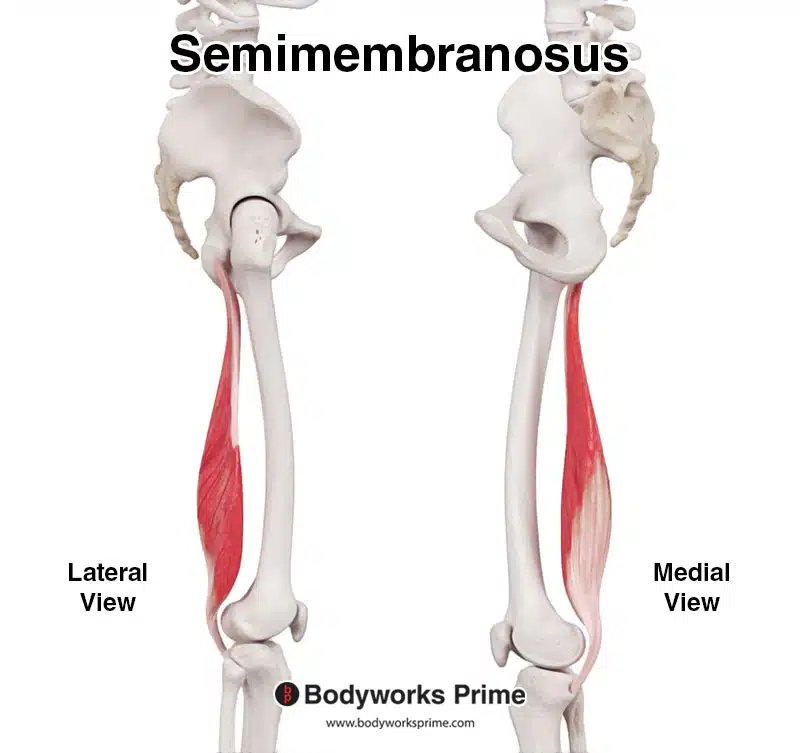
On the left, we can see a lateral view of the semimembranosus muscle. On the right, we can see a medial view.
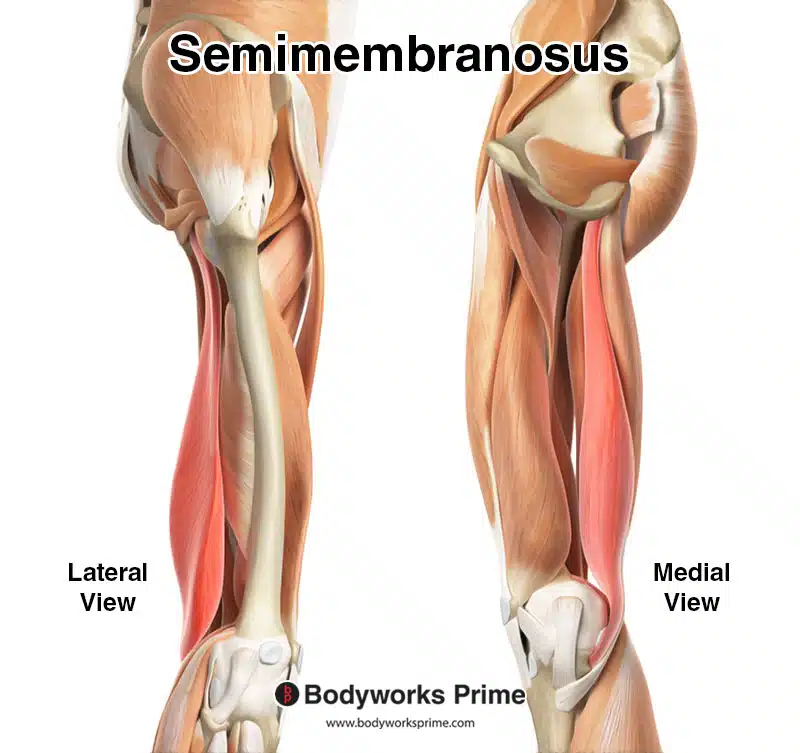
Here we can see the semimembranosus muscle highlighted in red amongst the other muscles of the leg. We can see a lateral view on the left and a medial view of the right. Muscles which are superficial to the semimembranosus have been removed, to better show its location.
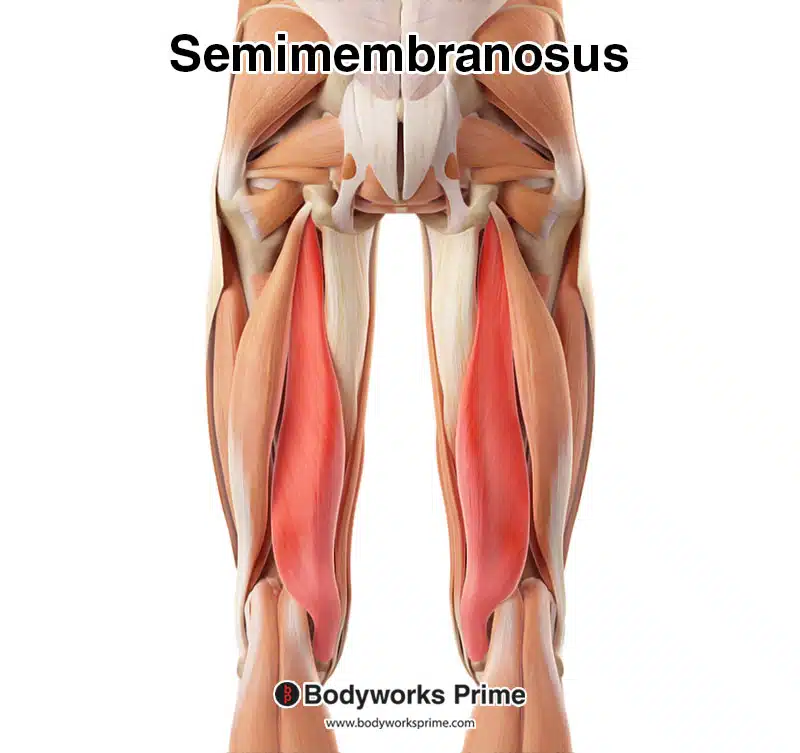
Here we can see the semimembranosus muscle highlighted in red, seen from a posterior view. Muscles which are superficial to the semimembranosus have been removed, to better show its location.
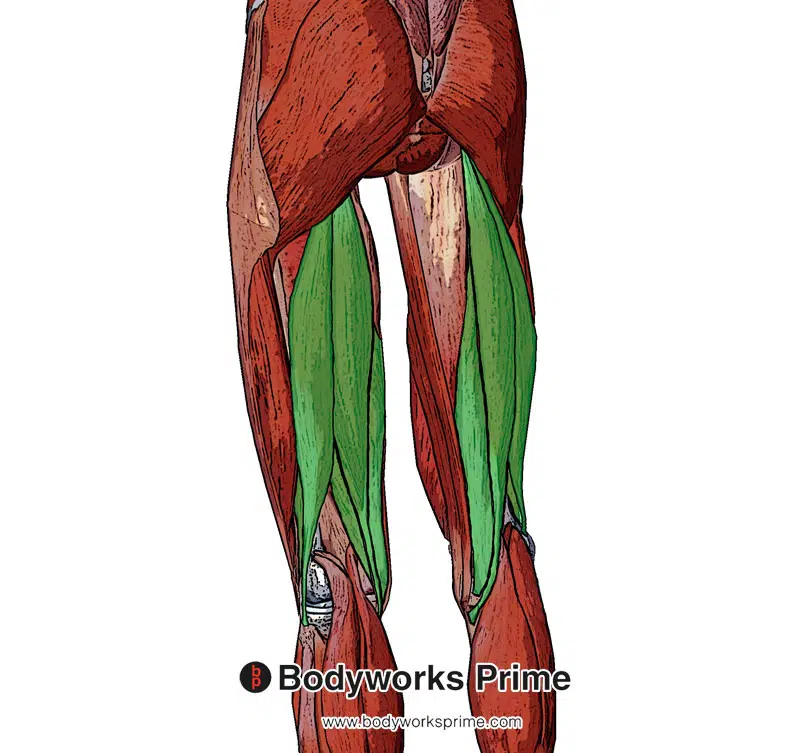
Pictured here are the hamstring muscles from a superficial view. The semimembranosus muscle is one of the three hamstring muscles. It is located deep to the semitendinosus muscle.
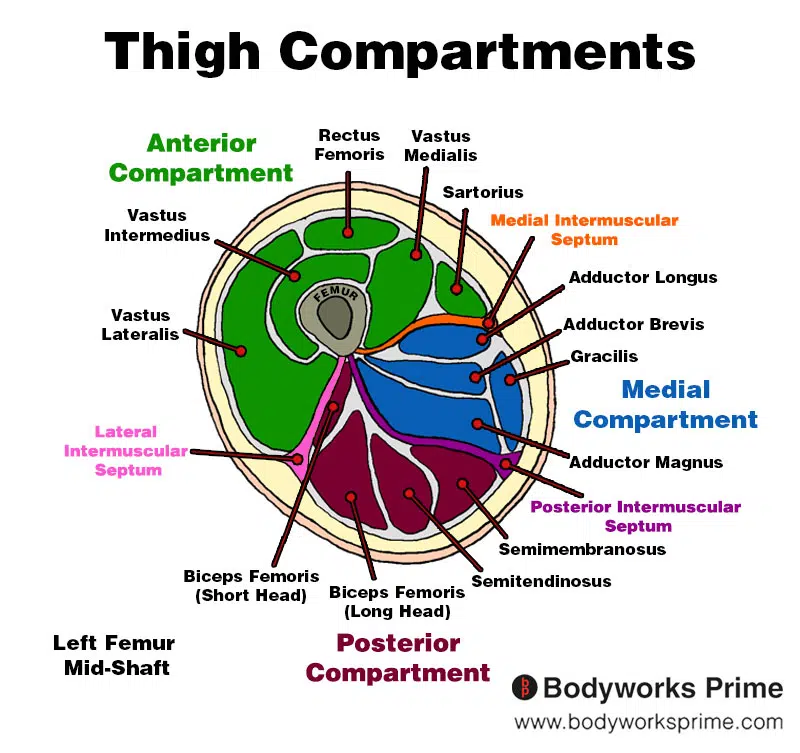
Here we can see an image of the compartments of the thigh. We can see the semimembranosus in the posterior compartment, the section coloured in red.
Origin & Insertion
The semimembranosus muscle originates from the ischial tuberosity, which is a prominent bony landmark located at the base of the pelvis. This is the same origin point as the semitendinosus muscle, and both muscles are part of the hamstring muscle group [3] [4].

Pictured here is the origin of the semimembranosus muscle marked in red. It originates on the ischial tuberosity.
After originating from the ischial tuberosity, the semimembranosus muscle extends down the medial aspect of the thigh and eventually inserts onto the medial condyle of the tibia. The medial condyle of the tibia is a bony prominence situated on the inner side of the upper tibia, which is the larger of the two bones in the lower leg [5] [6].
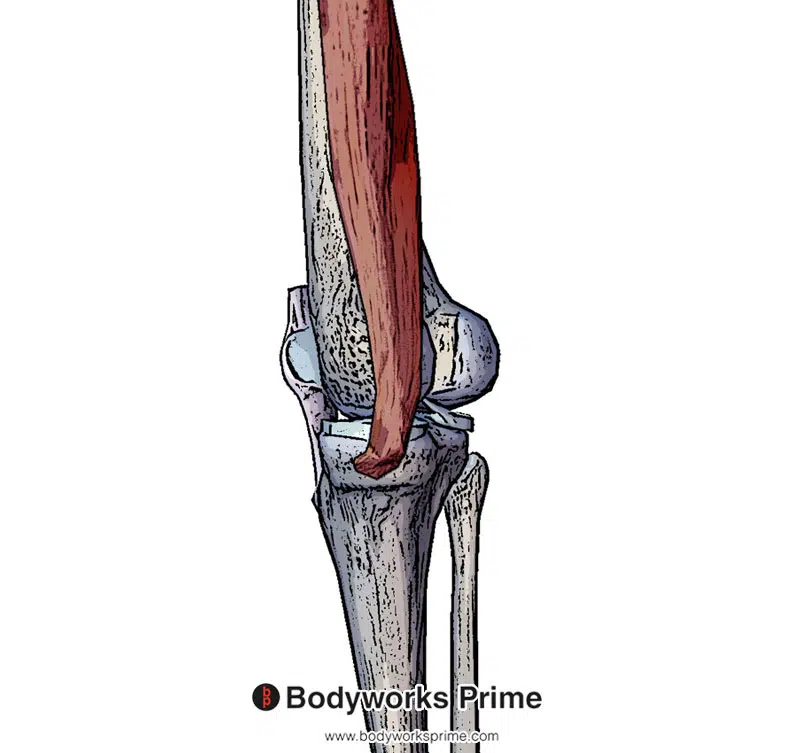
Pictured here is the distal tendon of the semimembranosus muscle where it inserts on the medial condyle of the tibia.
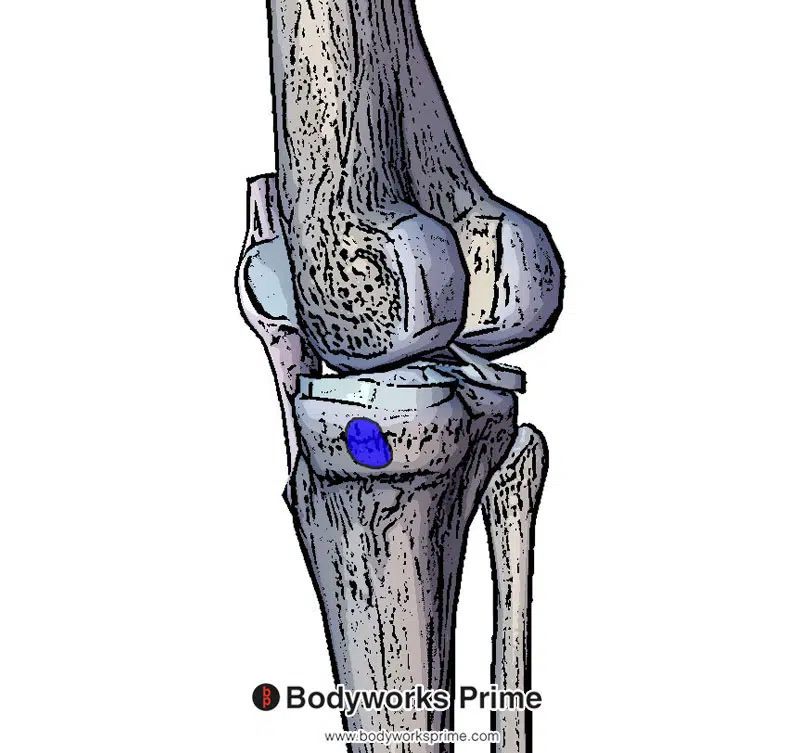
Pictured here is the insertion of the semimembranosus muscle marked in blue on the medial condyle of the tibia.
Actions
The semimembranosus muscle contributes to several important movements of the lower limb. Its primary functions are flexing the knee joint, extending the hip joint, and medially rotating the knee joint when the knee is flexed [7] [8].
Flexion of the knee joint refers to bending the knee, this action brings the lower leg closer to the back of the thigh. In contrast, extension of the hip joint occurs when the thigh moves backwards in relation to the hip, as seen during walking or running [9] [10].
The semimembranosus muscle also contributes to the medial (inward) rotation of the knee joint (or tibia) when the knee is flexed. This action involves rotating the lower leg (tibia) inward relative to the thigh. This can be visualised by bending the knee and then turning the foot inward without moving the thigh [11] [12].

In this image, you can see an example of knee flexion, which is the action of bending your knee. The opposite movement of knee flexion is knee extension. Knee flexion is an action of the semimembranosus muscle.
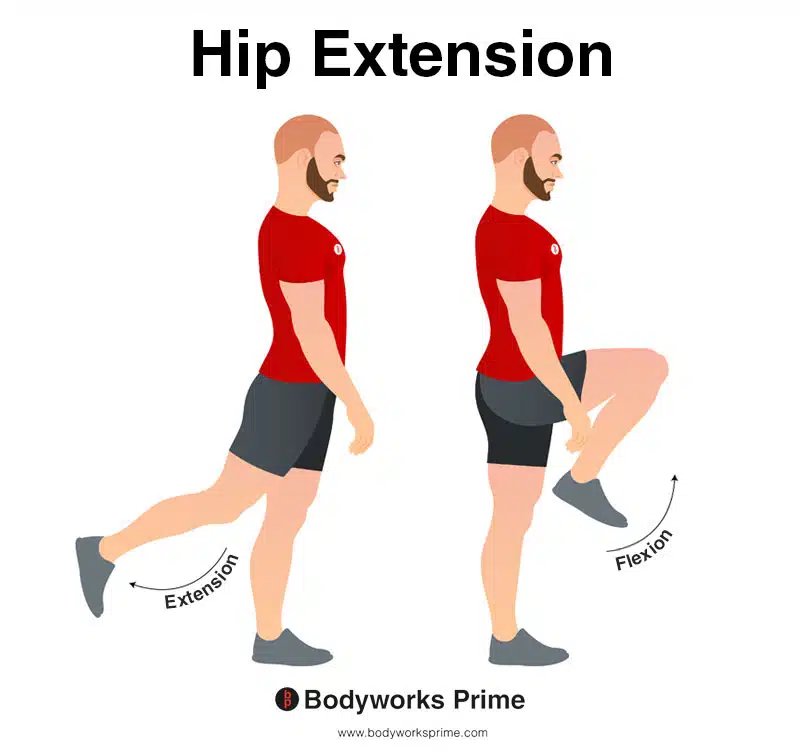
In this image, you can see an example of hip extension. Hip extension is the movement of the thigh or the upper leg backward, away from the body, in the sagittal plane. This action involves increasing the angle between the thigh and the pelvis, causing the hip joint to straighten or extend. The opposite movement of hip extension is hip flexion. Hip extension is an action of the semimembranosus muscle.
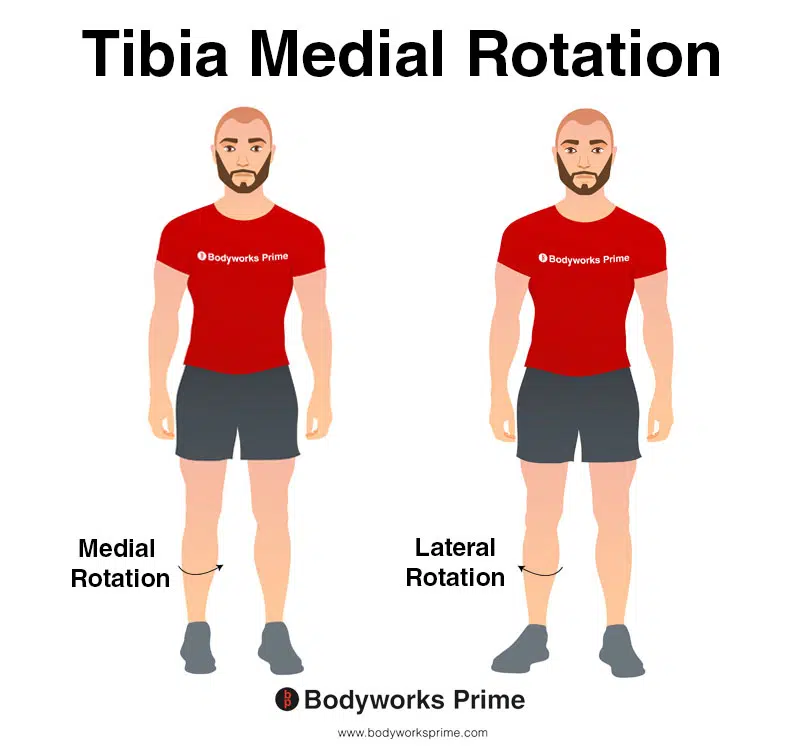
In this image, you can see an example of medial rotation of the tibia. Medial rotation of the tibia involves inward rotation of the shinbone towards the midline of the body. The opposite movement of medial rotation of the tibia is lateral rotation of the tibia. Medial rotation of the tibia is an action of the semimembranosus muscle, but only when the knee is flexed.
Innervation
The semimembranosus muscle is innervated by the tibial division of the sciatic nerve, which is derived from the spinal levels of L5, S1, and S2. The sciatic nerve is the largest and longest nerve in the body. It originates from the lumbosacral plexus, which is a network of nerves located in the lower back region. The tibial division of the sciatic nerve travels down the posterior aspect of the thigh, providing motor innervation to the hamstring muscles, including the semimembranosus [13] [14].

Here we can see the sciatic nerve. Even though the tibial nerve separates from the sciatic nerve just above the knee, it’s important to note that the nerves in our body are organised in a network, not in a strictly linear path. The nerve fibers that will eventually form the tibial nerve are present within the sciatic nerve from the point at which it leaves the spinal cord. These fibers “travel” within the sciatic nerve and reach the muscles they innervate, including the proximal (top) part of the semimembranosus muscle, long before the physical branching of the tibial nerve occurs near the knee. Thus, it’s still accurate to say that the semimembranosus is innervated by the tibial nerve, even though the physical branching occurs distally.
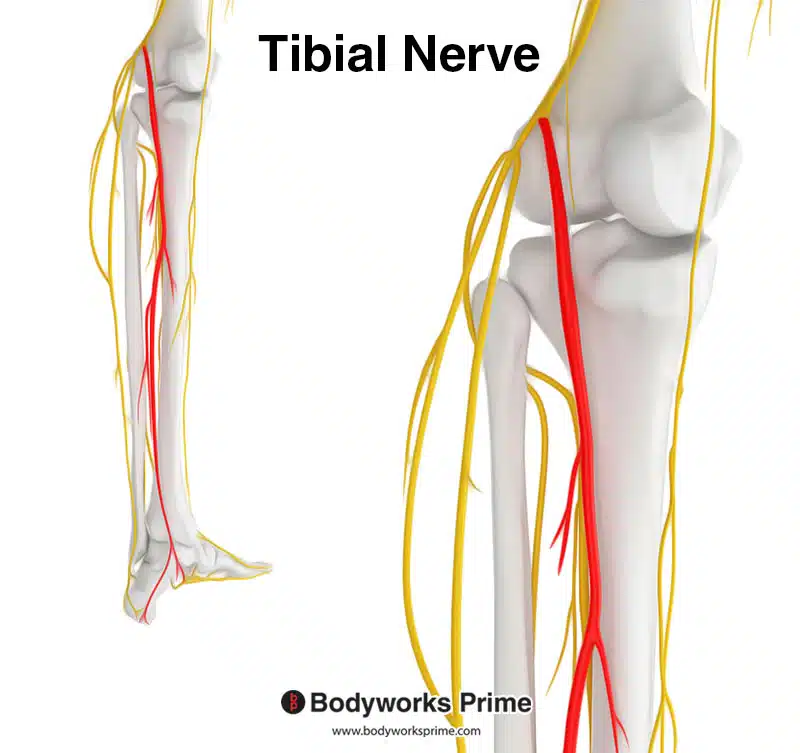
Here we can see the tibial nerve branching off from the sciatic nerve. The tibial division of the sciatic nerve innervates the semimembranosus muscle.
Blood Supply
The primary arteries supplying the semimembranosus muscle are the profunda femoris artery and the gluteal arteries. The profunda femoris artery (also known as the deep femoral artery) branches off the femoral artery and supplies blood to the muscles of the thigh, including the hamstring muscle group. The gluteal arteries, which consist of the superior and inferior gluteal arteries, arise from the internal iliac artery and contribute to the blood supply of the muscles in the gluteal and thigh regions, including the semimembranosus muscle [15] [16].
Want some flashcards to help you remember this information? Then click the link below:
Semimembranosus Muscle Flashcards
Support Bodyworks Prime
Running a website and YouTube channel can be expensive. Your donation helps support the creation of more content for my website and YouTube channel. All donation proceeds go towards covering expenses only. Every contribution, big or small, makes a difference!
References
| ↑1, ↑2 | Moore KL, Agur AMR, Dalley AF. Clinically Oriented Anatomy. 8th ed. Philadelphia: Lippincot Williams & Wilkins; 2017. |
|---|---|
| ↑3, ↑5, ↑7, ↑9, ↑11, ↑14 | Rodgers CD, Raja A. Anatomy, Bony Pelvis and Lower Limb, Hamstring Muscle. [Updated 2021 Aug 11]. In: StatPearls [Internet]. Treasure Island (FL): StatPearls Publishing; 2021 Jan-. Available from: https://www.ncbi.nlm.nih.gov/books/NBK546688/ |
| ↑4, ↑6, ↑8, ↑10, ↑12 | Afonso J, Rocha-Rodrigues S, Clemente FM, et al. The Hamstrings: Anatomic and Physiologic Variations and Their Potential Relationships With Injury Risk. Front Physiol. 2021;12:694604. Published 2021 Jul 7. doi:10.3389/fphys.2021.694604 |
| ↑13, ↑16 | Standring S. (2015). Gray’s Anatomy: The Anatomical Basis of Clinical Practice, 41st Edn. Amsterdam: Elsevier. |
| ↑15 | Tomaszewski KA, Henry BM, Vikse J, Pękala P, Roy J, Svensen M, Guay D, Hsieh WC, Loukas M, Walocha JA. Variations in the origin of the deep femoral artery: A meta-analysis. Clin Anat. 2017 Jan;30(1):106-113. doi: 10.1002/ca.22691. Epub 2016 Feb 2. PMID: 26780216. |










